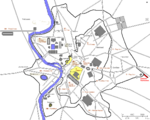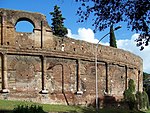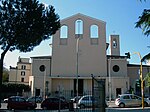Lodi (Rome Metro)
2015 establishments in ItalyItalian railway station stubsItalian rapid transit stubsRailway stations in Italy opened in the 2010sRailway stations opened in 2015 ... and 2 more
Rome Metro Line C stationsRome Q. VIII Tuscolano

Lodi is an underground station of Line C of the Rome Metro. It served as the western terminus of Line C since its opening, on June 29, 2015, until May 12, 2018, when the terminus moved to San Giovanni. The station is not exactly located in Piazza Lodi, after which it is named, but further west in Via La Spezia, between Via Orvieto and Piazza Camerino. Works started in 2007 and were finished in January 2015. The station opened on 29 June 2015.
Excerpt from the Wikipedia article Lodi (Rome Metro) (License: CC BY-SA 3.0, Authors, Images).Lodi (Rome Metro)
Via La Spezia, Rome Municipio Roma VII
Geographical coordinates (GPS) Address Nearby Places Show on map
Geographical coordinates (GPS)
| Latitude | Longitude |
|---|---|
| N 41.886732 ° | E 12.517762 ° |
Address
New Las Vegas
Via La Spezia 62
00182 Rome, Municipio Roma VII
Lazio, Italy
Open on Google Maps









